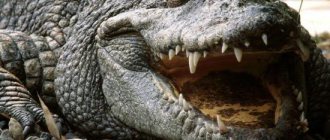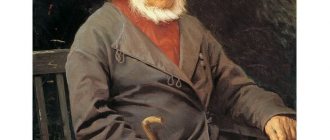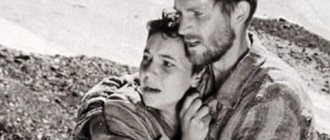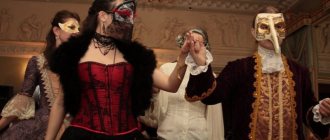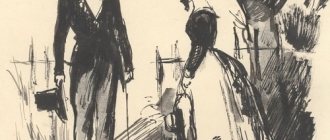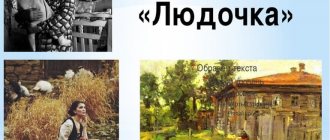Part one
In the morning the sun spills over the surface of the sea. A mile from the shore there is a fishing boat. A call resounds over the water. Seagulls flock for breakfast. Each bird tries to grab a better piece for itself.
A seagull named Jonathan Livingston does not participate in the general feast. He trains in splendid isolation, trying to shape his wings to slow down his flight as much as possible. During training, the seagull falls, which is considered completely unacceptable for these birds, but this worries him little: unlike others, Jonathan Livingston is more interested in new flight techniques than in food. Such a position in life does not add to his popularity in the Pack. The seagull's parents also don't quite understand him: his mother is worried that he hardly eats; the father suggests studying ways to obtain food, since his son is already so drawn to something new. For several days Jonathan honestly tried to participate in the general struggle for fish offal and crusts of bread, but he never managed to develop a serious attitude towards this. Livingston returned to flying practice again and in just a week learned more about flight speed than the fastest seagull in his entire life. Having passed the ninety-mile speed mark, Jonathan crashed into the hard surface of the sea.
"Jonathan Livingston Seagull", an artistic analysis of the story by Richard Bach
Richard Bach's novel Jonathan Livingston Seagull was first published in 1970. By 1972, the work had reached a circulation of one million copies and gained worldwide fame.
In terms of its genre, “Jonathan Livingston Seagull” gravitates towards two epic forms: a story (due to its chronicle plot) and a parable (a short allegorical narrative containing teachings of a religious and moral nature).
The story-parable opens with the author's dedication: “To the True Jonathan – the Seagull who lives in each of us.” In it, Richard Bach sets the main tone of the narrative, aimed at revealing the main artistic idea of the work: an attempt to convince the reader that he is free. Seagull Jonathan Livingston is each of us: what he could become if he rose above everyday life, strived for new knowledge and tried to know his true essence, which does not obey the laws of either space or time.
The classic Jonathan Livingston Seagull consists of three parts. The fourth was added by the author quite recently (in 2014) and has not yet reached a wide range of readers.
The first part of the story tells the story of a unique seagull named Jonathan Livingston. The first part is compositionally divided into two parts: in the first half the difference between the main character and the rest of the seagulls is shown (he is more interested in new flight techniques than in food; his parents do not understand him, who believe that he eats little (mother) and, if he is so drawn to new knowledge, he can study ways of obtaining food (father); he is not ashamed of falling into the sea, trying to achieve perfection in flight). In the second half, Jonathan Livingston, who has come to his senses after an unsuccessful attempt to develop high speed, experiences a turning point: having come to terms with the fact that he is a seagull and must live like everyone else, he goes home and suddenly realizes that he is no longer doing what he is capable of. seagulls - flying in the dark. New knowledge completely changes Jonathan Livingston's view of the world: he begins to transform its physical laws to suit himself, achieves great success in various flight techniques and finds himself expelled from the Flock. The seagull spends its entire subsequent life alone. New knowledge opens up not only spiritual prospects for him, but also significantly makes earthly life easier: Jonathan gains access to delicious fish living in the depths of the sea; it can fly far to the mainland and feed on land insects. Bad weather no longer bothers the seagull, as it can always soar above the clouds. Jonathan's earthly life ends with the arrival of two seagulls, shining like stars, who call him home.
In the second part, Jonathan Livingston lives a new life in another world - more perfect than the earthly one, but just as physically limited - for example, the speed that a seagull can reach. The concept of afterlife is built by Richard Bach in accordance with Eastern religions, which believe that Heaven is not a place, but only a path to true perfection. The last Jonathan passes under the guidance of the Elder named Chiang, who teaches his ward to move in space and time with just the power of thought. This, according to Chiang and the author himself, is possible provided that one recognizes oneself as a free being, devoid of any physical characteristics. Having completed his mission and learned everything that the new world can give him, Chiang goes upward - to other, more advanced knowledge, while Jonathan comes to the idea that he needs to return to Earth. The seagull sees in this a manifestation of true Love, which Chiang bequeathed to him to find.
The second part of the story, like the first, is divided into two halves. The second, extremely short in volume, serves as a preface to the third: in it the reader meets a new hero - another Exile, the seagull Fletcher Lind.
In the third and final part of the story, Jonathan Livingston, who received yet another reincarnation on Earth, becomes a teacher for Fletcher and six other Exiled Seagulls. He trains the first for three months, the rest for a month, after which he invites everyone to return to the Council Shore, thereby violating the Law of Exile and challenging the darkness and ignorance of ordinary birds. In this part of the story, the Christian idea of love for one’s neighbor – the “dumb-witted” and imperfect – comes to the fore. “Learn to see the true Seagull in them, perceiving the best that is in them, and helping them to consider this best themselves,” Jonathan says to Fletcher, putting an exclusively Orthodox meaning into these words. The scene of the flight of Kirk Maynard, a seagull with a broken left wing, also becomes a Christian reminiscence in the story.
All the characters and events in Jonathan Livingston Seagull serve as an allegory to convey classical human ideas about the world. Seagulls are people who, for the most part, are concerned with material wealth (it is no coincidence that each hero has a first and last name). The flight of seagulls is a style of human life based on the immutable Law of the Flock (that is, the crowd), which does not allow one to go beyond the usual norms. The Council is a symbolic image of the court, which does not accept anything that goes against the Law, even if it can benefit the Pack. Jonathan's desire to understand the world is an attempt by individual extraordinary individuals to find out the meaning of life. The latter is thought of by Richard Bach as two-sided: on the one hand, a person must improve himself, on the other, he must help others in this. The latter, in the author’s opinion, is true Love for one’s neighbor.
- “A Seagull Called Jonathan Livingston,” a summary of the chapters of the story by Richard Bach
- Richard David Bach, short biography
Based on the work: "A Seagull Named Jonathan Livingston"
By writer: Richard Bach
***
Consciousness returned to the seagull when it was already completely dark. Dreaming of going under, Jonathan heard a voice deep within himself that said that he was a seagull and he needed to live in accordance with his capabilities. Livingston decides to join the Pack and become like everyone else. He heads towards the shore when he suddenly realizes that seagulls never fly in the dark, because this requires the eyes of an owl. At the same time, it dawns on Jonathan how to turn the wings of a seagull into the wings of a falcon. He climbs two miles into the air, accelerates to one hundred and forty miles per hour and successfully recovers from his dive. In the morning, Jonathan takes off to a height of five miles, picks up a speed of two hundred and fourteen miles per hour and almost dies when he crashes into a feeding Flock. The seagull trains all day: he soars to an altitude of eight miles and masters the high-speed turn, the loop, the half-roll, the barrel roll, the slide and the vertical wheel. Proud of his successes, Jonathan returns to the Flock, where he attends a general meeting, is called by the elder to the Circle and is subjected to general censure as one who tramples on the traditions of the respectable Seagull Family. Livingston is banished to the Far Rocks, but he flies even further.
New knowledge opened up the possibility for Jonathan to catch rare and very tasty fish that live in the depths, and land insects that live far on the mainland. Livingston could cover vast distances by learning to sleep on the fly, and not be afraid of rain and fog, rising high above the clouds.
One evening Jonathan was found by two seagulls who could fly exactly like him. Birds shining like stars called the seagull home. Rushing after them, Jonathan left the earthly world.
Part two
As the seagulls rose higher and higher into Heaven, Jonathan's body became more and more similar to the bodies of his companions. He felt twice as strong, but still couldn’t reach a speed of more than two hundred and seventy-three miles per hour. When Jonathan reached the new shore, he was surprised at how few seagulls there were. Feeling tired, Livingston lay down on the sand and fell asleep.
In the following days, Jonathan, along with other seagulls, improves his flight technique. From instructor Sullivan, the seagull learns that birds that have not achieved Knowledge, in their next life again find themselves in exactly the same world from which they left. An elder named Chiang explains to Jonathan that Heaven is just a path to personal perfection and nothing more. For Livingston, this way could be perfect speed, allowing him to be in any place and time.
Chiang teaches the seagull to move at the speed of thought by abandoning the perception of itself as a creature with physical characteristics and imagining the place in which it already finds itself. At first, nothing works out for Jonathan. He achieves success only by realizing that he has always been a perfect being. On a planet with green skies and a double sun, Chiang tells Jonathan that he needs to learn to control his movements.
Upon returning, the seagull learns to navigate in the past and future. A month later, Chiang goes up, commanding everyone to improve and know Love.
The more Jonathan learns goodness, the more often he remembers the Earth. He begins to understand that his way of showing Love is to become a teacher for other seagulls.
Sullivan dissuades Jonathan from returning to Earth, saying that no one there needs his knowledge. Chaika trains with the local Newbies for a while, but eventually decides to return. He tells Sullivan that they can always meet one more time or two in the Here and Now.
Richard Bach and his seagull - briefly about the author
Richard Bach was born on June 23, 1936 in the American city of Oak Park, Illinois. Being the son of Roland and Ruth (Shaw) Bach, Richard Bach, according to family tradition, is the great-great-great-grandson of the well-known great composer Johann Sebastian Bach.
Since childhood, Richard has been passionate about flying and his whole life is connected with the sky. He served in the United States Air Force, was a member of the New Jersey Guard, 108th Fighter Wing, and later became an aviation instructor. He devoted his entire life to aviation, forever in love with the skies.
Richard Bach never considered himself a mystic, esotericist, sage or guru. His activities are very far from this. But reading his works, one cannot doubt that this man definitely has deep esoteric knowledge and uses it in his life. All his books are fiction, but at the same time autobiographical. Many are written in the first person.
The author's life is not easy. Behind him are unsuccessful marriages, difficulties at work, risks in flights, and even a tragedy that happened to him in 2012.
On August 31, 2012, Bach tried to land on a grass runway in a small plane, but hit power lines, damaging power lines in two places. Broken wires caused a fire. The crash site was discovered by a group of tourists who helped deliver the writer, who was in serious condition, to the hospital.
No, Richard Bach does not write about how to achieve enlightenment by sitting in the lotus position and smelling daisies. Or that knowing some truths will make your life cloudless. His book is all about perseverance, courage, high goals, will, strength, determination, love and humanity. In a word, about Life and how not to lose heart despite difficult circumstances.

